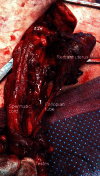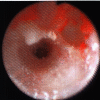Indirect inguinal hernia with uterine tissue in a male: A case of persistent Mullerian duct syndrome and literature review
- PMID: 23671501
- PMCID: PMC3650826
- DOI: 10.5489/cuaj.253
Indirect inguinal hernia with uterine tissue in a male: A case of persistent Mullerian duct syndrome and literature review
Abstract
A 32-year-old male presenting with a direct inguinal hernia was found to have uterine tissue extending through the inguinal canal, warranting a diagnosis of persistent Mullerian duct syndrome (PMDS). PMDS is an extremely rare form of internal male pseudo-hermaphroditism in which female internal sex organs, including the uterus, cervix and proximal vagina, persist in a 46XY male with normal external genitalia. The condition results from a congenital insensitivity to anti-Mullerian hormone, or lack of anti-Mullerian hormone, leading to persistence of the female internal sex organs in a male. Clinically, this condition is associated with cryptochoridism. Controversy persists regarding the appropriate treatment of PMDS, since resection of the remnant structures is associated with potential morbidity, but retention risks development of occasional malignancies. We review the literature and discuss various aspects of pathophysiology, diagnosis, and management of PMDS.
Figures





References
-
- Josso N. Biology and genetics of anti-Mullerian hormone. In: New MI, Simpson JL, editors. Hormonal and Genetic Basis of Sexual Differentiation Disorders and Hot Topics in Endocrinology: Proceedings of the 2nd World Conference. Vol. 707. New York, NY: Springer New York; 2011. pp. 83–5.
LinkOut - more resources
Full Text Sources
Other Literature Sources
Molecular Biology Databases
